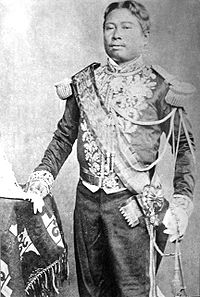Monday, May 25, 1896
The London Times
More pictures here.
King Norodom
A Curious Country in the East and Its Queer Old Potentate.
The night after my arrival in
Pnom-pehn, there was a reception in state at the French residency. It
was known that the king was to be present, and 28 of his loyal subjects
crouched in the shade opposite the residency to witness his reception. A
body of native militia, the Milliciens Cambodians, kept untidy guard in
the street, and when the king drove up in a Victoria, escorted by 11
Cambodians on ponies and followed by the victorias of a selection of his
sons, there was considerable enthusiasm. His majesty was received with
“Present arms!” and the fanfare of a cornet that was not in tune. Music
was played during the reception by the royal band of Manilla, men who
would have played, perhaps with more spirit had their wages been less in
arrears.
King Norodom is quite a curiosity. He is a little wizened up man, with gray hair and a stoop and with that peculiar expression of feature which is usually – I write with that respect – associated with the higher anthropoid apes. All the royal family live in Pnom-penh, in a kind of mock palace, a rambling pile of disjointed buildings of different shapes, scattered over a large inclosure, surrounded by a wall of brick and plaster. Where there is plaster it is falling off in flakes, where there is wood it is eaten and rotten, where there is any iron it is rusting and useless. It is a palace fit for such a king. At the main entrance to the palace two Cambodian militiamen keep guard with their hats awry, their khaki coats in rags, their rifles held like brooms. On the river bank in front of the palace there is an old flagstaff, while drawn above the water line there is a royal state barge, with dragon head and seven forked tail; but the paint has peeled off and the craft is no longer sea worthy.
King Norodom has reigned in his own peculiar way in Cambodia since 1860, but since 1867 he has the advantage of being directed and protected by the French. It was in 1867 that France entered into a treaty with Siam, by which she agreed that the two provinces of Angkor and Batambang should remain in Siamese possession, and by the same treaty Siam formally recognized the French protectorate in Cambodia. Since 1867, then, we are always told that Siamese influence was withdrawn from the councils of Cambodia. As an actual fact, however, Siamese influence still counts for something, thought the French will not allow that it is so in the Cambodian court. Norodom passes his early years in Bangkok and spoke Siamese before he spoke Cambodian. It was Siam which gave the crown of Cambodia to his father, Ang-Duong, and it was Siam which elected him king on the death of his father. The king is not a prince of high moral character. He has probably never attempted to escape from the trammels of his environment. He will even on occasions mock at Buddha, but, none the less, he cannot forget that for him the highest living object of religious veneration must be the king of Siam. In Pnom-pehn there are nearly 40 Siamese employed by the king in positions of more or less confidence, and I have it on authority which is beyond cavil that the most intimate personal friends of the king and his only confidants are Siamese, and that Siamese is the language which the royal lips speak from choice.
King Norodom is a very much married man, his establishment comprising at least 800 wives and concubines. He has 56 sons and daughters, who are recognized by the French as his lawful progeny. Of this number more than half are sons, so that the succession, if ever the French permit him to have a successor, is well assured. King Norodom came to the throne in 1860, and the same year a statue in his honor was erected in Pnom-pehn. It is an equestrian statue and is the only public monument in the city. It was of course made in France and represents the king dressed as a French general, mounted on a charger and saluting the armed hosts of Cambodia [KI-Media will provide more details on the origin of this statue at a later date]. Rarely have I seen a more impressive work of art, and it is unfortunate that, left neglected in some waste land, it has become overgrown with jungle. On the pedestal there is an inscription which testifies that the statue was erected to Norodom by his “grateful mandarins and subjects.” The statue, we are told, was the spontaneous offering of a grateful people, and one can well believe it, though it surely has not often happened that indigenous tribes in Asia have ordered from Paris equestrian effigies of their newly crowned kings. – London Times.


1 comment:
Wow...that's pretty bad. Way to go Cambodia.
Post a Comment